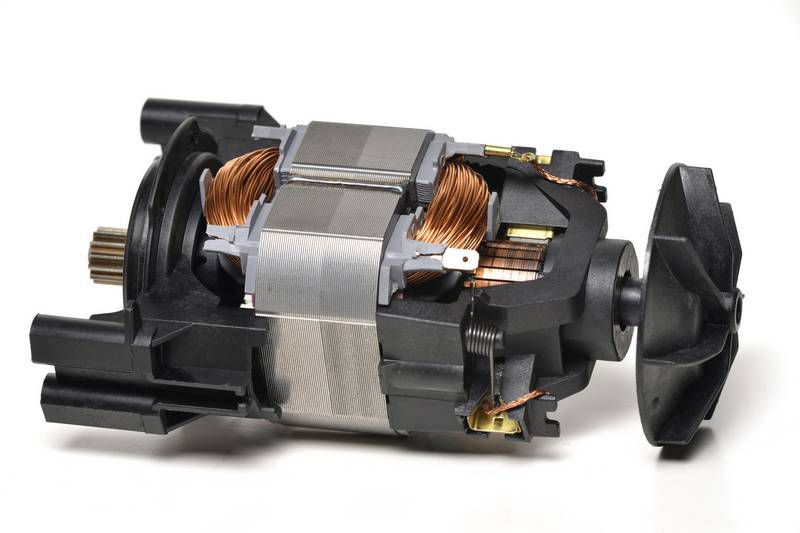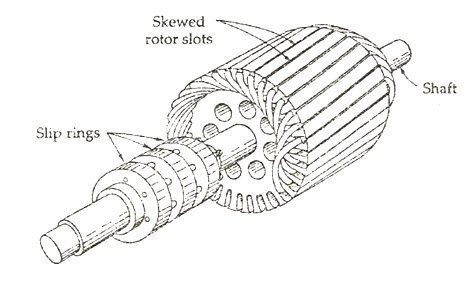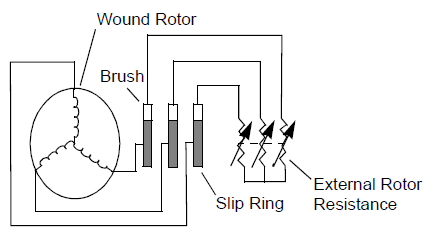
I will tell you about the construction of Wound Rotor Induction Motor in the first section. In the second section, I would be throwing light on the operation and working principle of Wound Rotor Induction Motor. After that, I will tell you some of the key features and uses of Wound Rotor Induction Motor.
Construction of Wound Rotor Induction Motor
As in other induction motors, the basic parts are stator and rotor. Stator of this motor is the same as the one used in squirrel cage induction motors. Rotor is the part which distinguishes it from other induction motors. Let me give you a brief idea of stator first and then I will tell you about the structure of rotor.

Stator of Wound Rotor Induction Motor
- As the name implies, stator is the stationary part of Wound Rotor Induction Motor.
- The stator and rotor are separated from each other by a small air gap.
- Stator of any type of induction motor is a cylindrical frame inside which rotor rotates.
- The cylindrical frame has grooves on its internal periphery to carry electrical circuitry.
- The stator winding is excited by AC supply.
- That was the basic structure of stator, now let’s talk about rotor.
Rotor of Wound Rotor Induction Motor
- In Wound Rotor Induction Motor, the rotor has a 3 phase winding similar to stator winding.
- Rotor is also cylindrical in shape and has slots to carry winding.

- The winding is placed evenly on slots of the rotor.
- are connected to 3 slip rings.
- These slip rings are mounted on the shaft.
- Each phase is connected to one of the three slip rings. These slip rings are associated with brushes.
- The three slip rings rotate with rotor, while brushes remain stationary.
- This is all about construction of rotor. Now let’s discuss the working principle.
Working of a Wound Rotor Induction Motor
- The working principle of Wound Rotor Induction Motor is as same as in any other induction motor.
- AC supply is given to stator winding, which produces a magnetic field that is rotating because of the time changing AC supply.
- The flux lines of the magnetic field will cut the rotor and induce an emf according to Faraday’s law.
- The induced emf will induce a current that will generate another magnetic field. This magnetic field is called rotor magnetic field.
- The magnetic field of stator and the magnetic field of rotor will interact and give rise to a torque which will turn the rotor.
This motor is different because the rotor windings are connected to external resistances through slip rings. The speed and torque can be adjusted in these motors by changing resistance. Now I am going to tell you about some of the key features of these motors.
You may also like to read:
- Introduction to Induction Motor.
- Single Phase Induction Motor.
- 3 Phase Induction Motor.
- Introduction to Synchronous Motor.
Key Features
Some of the features of wound rotor induction motors are as under:
Speed Control
- It is possible to control the speed of such motors. The torque can also be controlled.
High Starting Torque
- These motors have high starting torque.
Maintenance
- Wound Rotor Induction Motor require more maintenance because of slip rings and brushes.
Cost
- Such motors are expensive than other induction motors. The maintenance cost also counts.
Low Starting Current
- This motor draws less current at start as compared to squirrel cage induction motors.
Efficiency
- Wound Rotor Induction Motor are less efficient than squirrel cage induction motors.
Power Factor
- These motors have a low power factor.
Now I am moving towards the last section, in which I am going to tell you all about some of the application areas of Wound Rotor Induction Motor .
Applications
The uses and applications of this induction motor are:
- They are used in areas where high starting torque is required. And where squirrel cage induction motors cannot be used because of their high starting currents.
- These motors are used with high inertia loads.
- Wound Rotor Induction Motor is used in applications which require smooth start and adjustable speed.
- Some of the applications of this motor include cranes, mills, hoists and conveyors.
- Wound rotor induction motor is also used in fans, blowers and mixers.
- They are used in large pumps in water industry.



